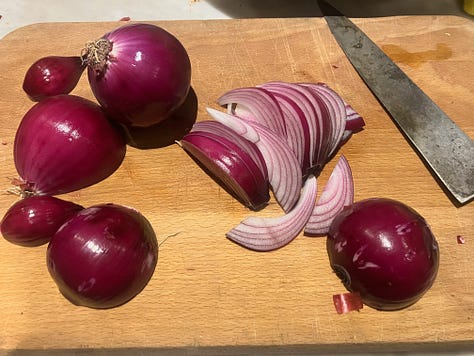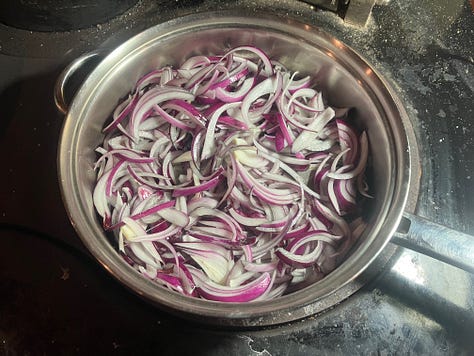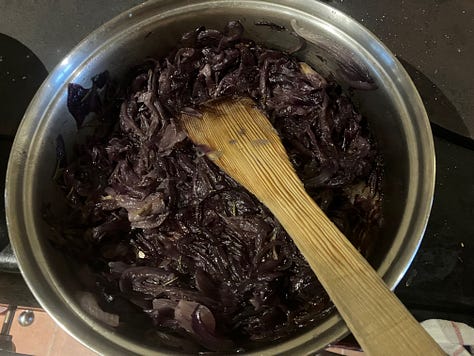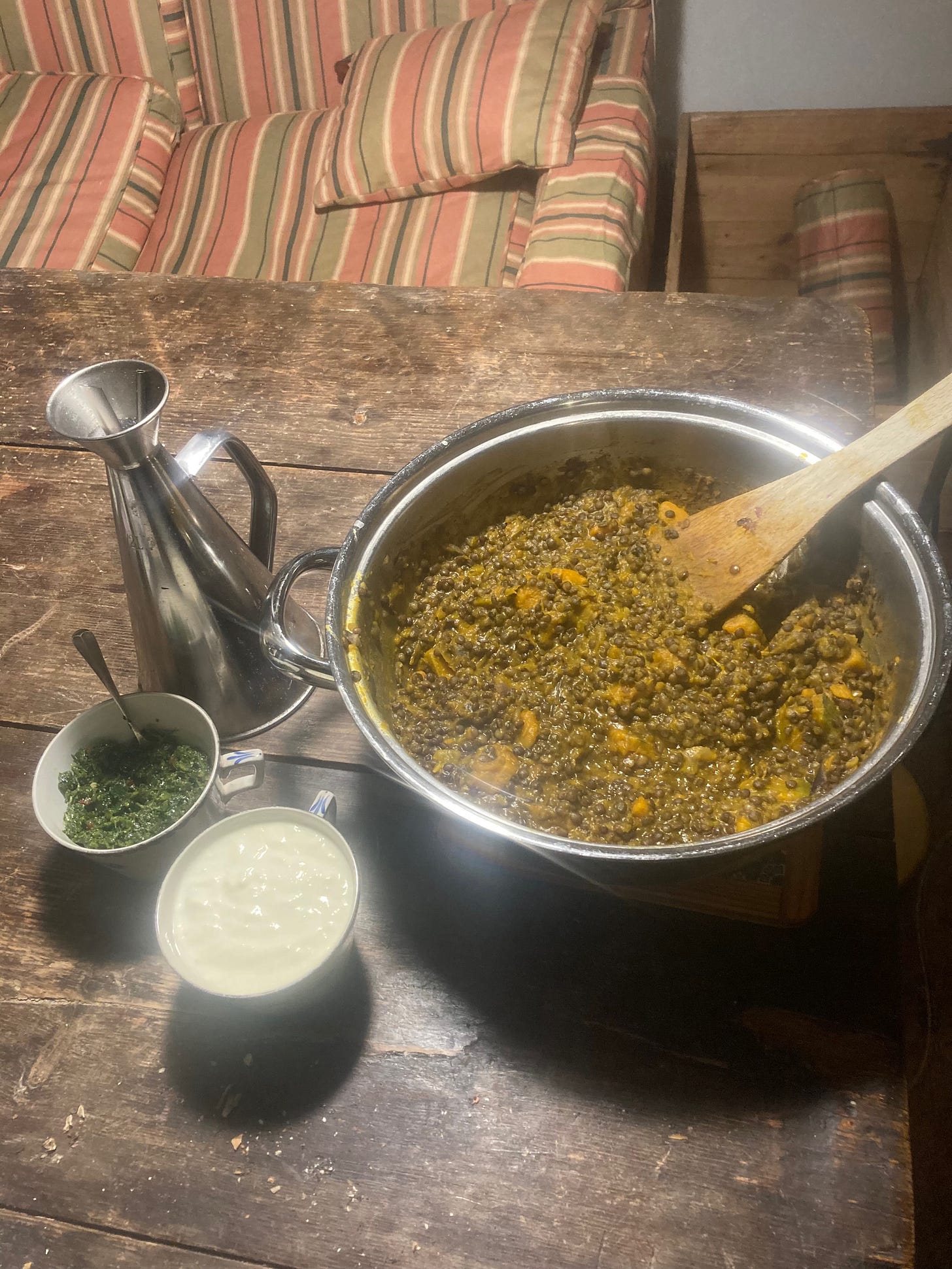Downsizing Masterclass: Caramelised Onions
How to achieve perfect caramelised onions without depleting world olive oil stocks; recipe for Lentils with Pumpkin, Sautéed Onion, and Zhoug



Without caramelised onions, all meaningful existence is blighted, but cooked in lashings of butter or olive oil they are not conducive to a thinner life, so when I worked out how to do them with butter or oil but no lashings, I was straight on the phone to the Nobel lot – and not without reason: as a contribution to the sum total of human happiness, it’s right up there with penicillin and a cure for malaria.
Still no answer, and it’s Nobel Prize-Giving Week.
Caramelised or Sautéed?
These terms are often used interchangeably, which is fair enough, given that either are a bit of both. However, I tend to think of sautéed as cooked at a slightly higher temperature for between 10 and 20 minutes, with result glistening and golden brown, and caramelised as cooked at a lower temperature for between 30 and 60 minutes, by which time the onions have lost all sense of personal identity, and are soft and densely sweet.
N.B. Have nothing to do with instructions that call for cooking onions till soft for 2 minutes... or 5 minutes. Onions do not cook in 5 minutes. Perpetrators of this dangerous myth must be reported to the authorities.
Quantity of oil or butter:
1/2 – 1 teaspoon of oil or butter for the pan.
1 – 2 teaspoons for up to 300g / 2 medium onions.
1 teaspoon is the minimum; 2 teaspoons make them quite a bit nicer, but I’m coming round to the view that using more oil than that doesn’t actually make much difference: it is the natural sweetness of the onions – and caramelising it – that make them taste so divine, rather than the quantity of oil or butter*.
*I would like to make it clear that I am a HUGE fan of both, and I only avoid them in big quantities because they are very calorie-dense. If your downsizing method allows unlimited olive oil – or you’re not downsizing – please glug away.
Preparing the Onions
1. Finely slice the onions with the grain rather than across it. Put them in a bowl with a good pinch of salt, and add the oil. Adding the salt at the same time as the oil draws out the juice, which helps with the caramelisation and brings out the sweetness of the onion – think salted caramel.
2. Use your hands to mix the oil into the onions, ensuring that they are really, really well-coated. It is this thorough mixing that makes it possible to use so little oil and still get a delicious result. If using butter, melt it first, before adding it to the onions.
3. Depending on size of the pan, heat ½ – 1 teaspoon of olive oil in the pan till it has spread out to cover the base, so you are not putting cold onions straight onto hot metal or non-stick coating.
*
For Sautéed:
1. Heat the oil on a middling heat until it covers the base of the pan, and add the onions. When they start to sizzle, stir them, put a lid on the pan, and turn the heat down a tad.
2. Keep the lid on for at least five minutes – it helps the onions cook without drying out. Stir fairly frequently.
3. After 5 – 10 minutes, take the lid off to condense the juices and cook till they are as brown as you want, and have the right amount of bite – or lack of it – for whatever you have in mind for them. The exact timing will depend on the onions, the heat, the pan, and whether you wander off and start doing something else.
Caramelised
1. Heat a teaspoon of oil in a pan on a low to medium heat until it has spread out to cover the whole of the base.
2. Add the onions. When they start to sizzle a little, stir, put a lid on them, and turn the heat right down.
3. Leave them on a low heat until the juices are beginning to come out – about 10 minutes.
4. For the next 20 – 40 minutes (depending on onions, heat, and pan), stir from time to time, and turn the heat up a bit and down a bit, depending on whether you want to encourage them or stop them burning or drying out.
5. Towards the end, take the lid off and turn the heat up a little to reduce the liquid and intensify the sweetness. Stir often at this stage. It would be tragic after all this time to burn the onions.
Sautéed Onions with Fruit
This is another way of cooking downsizing onions, which is also very good. You can use any fruit, but right now apples are a really good idea.
2 red onions
1 piece of fruit – fig, peach, apple
A good pinch of salt
2 teaspoons olive oil or butter, plus one for the pan
Finely slice the onions.
Chop up the fruit. If using an apple, grate it.
Put the onions and fruit in a bowl; add a pinch of salt and 2 teaspoons of oil or melted butter, and mix really well, making sure the onion is well coated.
Heat 1 teaspoon of oil or butter in a frying pan. Add the mix of onion and fruit. Cook with the lid on for 5 – 10 minutes. Take the lid off and cook on a medium heat till golden brown and glistening.
Lentils with Pumpkin, Sautéed Onion, and Zhoug
I have posted this recipe before, but it’s one of my favourites, and my many new subscribers have not yet seen it.
It combines three of my favourite things – lentils, onions, and very few ingredients; it emerged out of the winter of outdoor socialising, and its delicious, comforting warmth practically saved my life. I still only have to hear the words, outdoor socialising, and my toes start threatening frostbite.
The zhoug recipe is inspired by one of my food heroes, Ottolenghi. On its own, it verges on being quite unpleasant, but its astringent burst of heat and spice gives an extraordinary counterpoint to the sweetness and comfort of the pumpkin and onion.
Serves 4
200g small lentils
A pinch of whole coriander, cardamom seeds, and black peppercorns
500g pumpkin, peeled and cut into 1cm cubes
1 large red onion, sliced thinly with the grain
Stock*
5 teaspoons olive oil
Zhoug – optional
Skyr** – optional
Salt and pepper
I either use fresh stock or water. There’s plenty of flavour in the vegetables without a stock cube.
** Unless I am having a totally LCD day, I use Greek Yogurt instead.
The Lentils:
Put the lentils in a saucepan, add the whole spices and a teaspoon of salt, and cover with plenty of water.
Bring them to the boil, and then turn down the heat and simmer for 20 – 30 minutes until soft but still firm. Drain and add more salt if needed. You can do this in advance and keep them in the fridge. You can also open a tin.
The Onion:
Heat 1 teaspoon of the olive oil in a sauté pan on a medium heat.
Put the onions in a largish bowl and add two teaspoons of oil with a good pinch of salt.
Mix really well with your hands to make sure that the onion is completely coated with oil.
Add them to the pan, wait till they start to sizzle, and then turn down the heat. When the onions start to soften and release their juices – about 10 minutes – turn the heat up slightly for another 10 minutes or so. Stir them from time to time.
The Pumpkin
Put the diced pumpkin in a bowl; add a good few grindings of salt and pepper and the remaining 2 teaspoons of olive oil.
Mix really well to coat the cubes, and add to the onion when it starts to colour. Cook for about five minutes, allowing the onion to continue caramelising, and then add just enough stock to cover.
Simmer till the pumpkin is cooked, and then add the lentils.
Heat through for a couple of minutes, adjusting the seasoning if necessary.
Serve with a teaspoon of zhoug and a dollop of skyr – or greek yogurt.
Zhoug
A large handful of parsley and /or coriander
2 hot green chillies
A pinch of ground cumin
A smaller pinch of ground cloves and cardamom
A good pinch of salt
One crushed clove of garlic
2 tablespoons / 30g olive oil
2 tablespoons water
Blitz them all together in a food processor
Diva Notes:
Preparing the pumpkin:
It takes serious muscle to peel and chop a pumpkin. Think of it as a free gym, and use a substantial peeler and a very sharp knife.
Zhoug
Do not attempt to make this by hand – the spices need to be extremely well melded together with the parsley and coriander or they sit gratingly on the surface.
You can make it in advance – it keeps very well in the fridge.



Interested to see your instruction about cutting with/against the grain of the onion. With is my preference for more evenly-sized slices but do you find it makes a difference in how the cook/how soft they get?